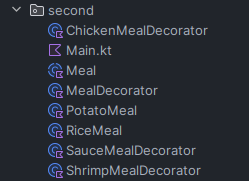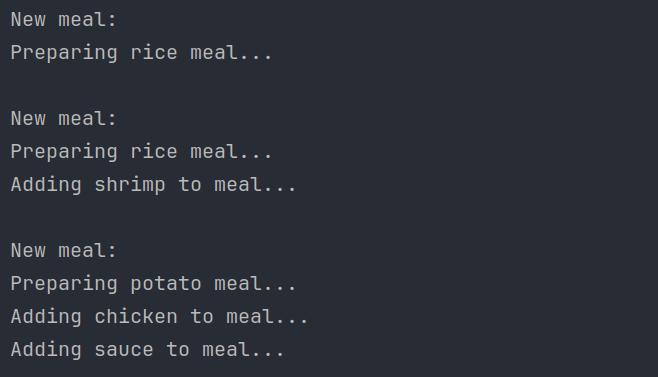Design patterns: Decorator

Decorator is one of structural design patterns, which enable us to add new functionalities to objects dynamically, without changing their source code. We can achieve this by placing particular object in other, wrapping object, which has appropriate behaviors.
Problem
Imagine, that you are chef in certain restaurant. You, as a chef, should prepare appropriate meals based on chosen ingredients. Restaurant, for which you work serves two types of meals: potato meal and rice meal. Additional ingredients, which you can add to each of them are: chicken, shrimps and sauce. Creating individual class for each ingredients combination (for example “Potato meal with chicken and sauce” or “Rice with shrimps”) would be impractical and difficult to extend/maintain, especially, when number of combinations will grow. By utilizing Decorator design pattern we can compose as many meals as you can imagine in simple way, without making big changes in code.
Implementation (Kotlin)
Project structure

Meal.kt
abstract class Meal {
open fun prepareMeal() {
println("Preparing meal...")
}
}
PotatoMeal.kt
class PotatoMeal : Meal() {
override fun prepareMeal() {
println("Preparing potato meal...")
}
}
RiceMeal.kt
class RiceMeal : Meal() {
override fun prepareMeal() {
println("Preparing rice meal...")
}
}
MealDecorator.kt
open class MealDecorator(private val decoratedMeal: Meal) : Meal() {
override fun prepareMeal() {
decoratedMeal.prepareMeal()
}
}
ChickenMealDecorator.kt
class ChickenMealDecorator(private val decoratedMeal: Meal) : MealDecorator(decoratedMeal) {
private fun addChicken() {
println("Adding chicken to meal...")
}
override fun prepareMeal() {
decoratedMeal.prepareMeal()
addChicken()
}
}
SauceMealDecorator.kt
class SauceMealDecorator(private val decoratedMeal: Meal) : MealDecorator(decoratedMeal) {
private fun addSauce() {
println("Adding sauce to meal...")
}
override fun prepareMeal() {
decoratedMeal.prepareMeal()
addSauce()
}
}
ShrimpMealDecorator.kt
class ShrimpMealDecorator(private val decoratedMeal: Meal) : MealDecorator(decoratedMeal) {
private fun addShrimp() {
println("Adding shrimp to meal...")
}
override fun prepareMeal() {
decoratedMeal.prepareMeal()
addShrimp()
}
}
Main.kt
fun main() {
println("New meal: ")
val riceMeal: Meal = RiceMeal()
riceMeal.prepareMeal()
println("\nNew meal: ")
val riceMealWithShrimp: Meal = ShrimpMealDecorator(RiceMeal())
riceMealWithShrimp.prepareMeal()
println("\nNew meal: ")
val potatoMealWithChickenAndSauce: Meal = SauceMealDecorator(ChickenMealDecorator(PotatoMeal()))
potatoMealWithChickenAndSauce.prepareMeal()
}
Output

Explanation
We have Meal abstract class, which has prepareMeal() method. PotatoMeal and RiceMeal classes extends Meal class and provide own implementations of this method. These classes represents our base meals without additional ingredients. Now we can cook potato meals and rice meals, but only in simple, boring form. To make adding other ingredients to our base meals possible, we should create next classes – decorators. First and most important is MealDecorator. It is base of each another decorator, which we will add and receives object of Meal class as an contructor argument. More precise decorators, which will enable us to add additional ingredients to meals are: SauceMealDecorator, ShrimpMealDecorator and ChickenMealDecorator. Each of them receives object of Meal class as an constructor argument, like MealDecorator class, extends MealDecorator class and invokes its constructor with given argument. Each of these “more precise” decorators has also own add…() method, which is invoked with invocation of prepareMeal() method. This method adds appropriate ingredient to our meal.
In main() function you can see practical example of meal preparation with usage of decorators. For example if you want to cook “Potato meal with chicken and sauce” you should firstly invoke PotatoMeal contructor, wrap it in a ChickenMealDecorator constructor and wrap ChickenMealDecorator in a SauceMealDecorator constructor.
Your implementation can be different! Treat this as a typical demonstration example.
Pros and Cons
✅ Possibility to extend functionality of class without modification of its base code (Open/Closed Principle).
✅ Avoiding complex inheritance hierarchies and reducing risk of a diamond problem.
✅ Reusability of decorators.
❌ Decorator is based on inheritance. In languages such as Java (where class can extend only one other class) usage of this pattern block us possibility to inherit from class, which we need from business perspective.